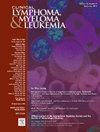CD19 CAR-T With Axicabtagene Ciloleucel in R/R Large B-Cell Lymphoma With/Without Prior Autologous Stem Cell Transplant
IF 2.7
4区 医学
Q2 HEMATOLOGY
引用次数: 0
Abstract
Background
Anti-CD19 CAR-T therapy has been a breakthrough in treatment of primary refractory or relapsed large B-cell lymphoma (r/r LBCL) and is poised to supplant previous second line of high dose chemotherapy and autologous stem cell transplantation (HDT/ASCT). However, in clinical practice, high risk patients with chemoimmunotherapy sensitive disease continue to receive salvage chemoimmunotherapy or cannot access CAR-T in a timely manner and thus may still proceed to HDT/ASCT. Little is known about clinical outcomes of CAR-T in patients who receive HDT/ASCT compared to those who are transplant-naïve.
Design
We conducted a retrospective study of patients with r/r LBCL who previously underwent HDT/ASCT or were transplant-naïve (n = 97) and received axicabtagene ciloleucel after at least 2 prior therapy lines between 1/1/2018 to 12/31/2021. Primary endpoint was progression-free survival (PFS). Secondary endpoints were overall survival (OS), nonrelapse mortality (NRM), and cumulative incidence of relapse/progression.
Results
82 (84.5%) patients were transplant-naïve and 15 (15.5%) previously received HDT/ASCT. No differences were found in the incidence of high-grade cytokine release syndrome or immune effector cell-associated neurotoxicity syndrome, length of hospital admission, or incidence of cytopenia at day 30. 90-day response, PFS, OS, cumulative incidence of relapse/progression, and NRM were not different. Factors that adversely affected outcomes were prior bridging therapy, elevated LDH or thrombocytopenia at time of lymphodepleting chemotherapy, and worse ECOG performance status.
Conclusion
Prior treatment with HDT/ASCT does not compromise the safety and efficacy of anti-CD19 CAR-T therapy, suggesting a continued role for HDT/ASCT in treatment of select patients with r/r DLBCL.
CD19 CAR-T联合阿西卡布他尼治疗R/R大b细胞淋巴瘤伴/未伴自体干细胞移植。
背景:抗CD19 CAR-T疗法在治疗原发性难治或复发大B细胞淋巴瘤(r/r LBCL)方面取得了突破性进展,有望取代以往的二线大剂量化疗和自体干细胞移植(HDT/ASCT)。然而,在临床实践中,对化疗免疫治疗敏感的高危患者仍在接受挽救性化疗免疫治疗,或无法及时获得CAR-T治疗,因此仍有可能接受HDT/ASCT治疗。与未接受移植的患者相比,接受 HDT/ASCT 的患者的 CAR-T 临床疗效鲜为人知:我们对既往接受过 HDT/ASCT 或无移植史的 r/r LBCL 患者(n = 97)进行了一项回顾性研究,这些患者在 2018 年 1 月 1 日至 2021 年 12 月 31 日期间接受了至少 2 种既往疗法后接受了 axicabtagene ciloleucel。主要终点为无进展生存期(PFS)。次要终点为总生存期(OS)、非复发死亡率(NRM)和复发/进展累积发生率:82名(84.5%)患者为移植免疫患者,15名(15.5%)患者曾接受过 HDT/ASCT。在高级别细胞因子释放综合征或免疫效应细胞相关神经毒性综合征的发生率、住院时间或第 30 天的全血细胞减少发生率方面未发现差异。90天反应、PFS、OS、复发/进展累积发生率和NRM没有差异。对疗效产生不利影响的因素包括之前的桥接疗法、淋巴细胞清除化疗时LDH或血小板减少率升高以及ECOG表现较差:结论:既往接受过HDT/ASCT治疗不会影响抗CD19 CAR-T疗法的安全性和疗效,这表明HDT/ASCT仍可用于治疗部分r/r DLBCL患者。
本文章由计算机程序翻译,如有差异,请以英文原文为准。
求助全文
约1分钟内获得全文
求助全文
来源期刊

Clinical Lymphoma, Myeloma & Leukemia
ONCOLOGY-HEMATOLOGY
CiteScore
2.70
自引率
3.70%
发文量
1606
审稿时长
26 days
期刊介绍:
Clinical Lymphoma, Myeloma & Leukemia is a peer-reviewed monthly journal that publishes original articles describing various aspects of clinical and translational research of lymphoma, myeloma and leukemia. Clinical Lymphoma, Myeloma & Leukemia is devoted to articles on detection, diagnosis, prevention, and treatment of lymphoma, myeloma, leukemia and related disorders including macroglobulinemia, amyloidosis, and plasma-cell dyscrasias. The main emphasis is on recent scientific developments in all areas related to lymphoma, myeloma and leukemia. Specific areas of interest include clinical research and mechanistic approaches; drug sensitivity and resistance; gene and antisense therapy; pathology, markers, and prognostic indicators; chemoprevention strategies; multimodality therapy; and integration of various approaches.
 求助内容:
求助内容: 应助结果提醒方式:
应助结果提醒方式:


